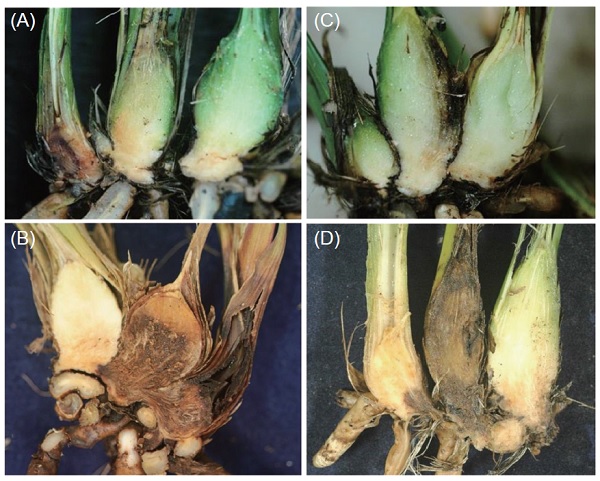All issues

Author:Chiao-Wen Huang, Jin-Hsing Huang*, Yi-Ching Li, Chun-Wei Chen, Szu-Lun Lai, and Ting-Fang Hsieh
Abstract:
Pseudobulb rot disease caused by Fusarium oxysporum is a major limiting factor of Oriental cymbidiums cultivation in Taiwan. In order to shorten the growth period, farmers usually use a shoot diving method for propagation instead of using tissue culture plantlets. However, the disease incidence of pseudobulb rot was up to 100% when the 1st generation shoot from the diseased mother plant were replanted in pots. Furthermore, the replanted plants of the 2nd and 3rd generation shoots from the diseased mother plants showed moderate high disease incidences, suggesting that the disease plantlets or generation shoots come from the disease plant were the major inoculum source. In the artificial inoculation tests, both the young and mature Oriental cymbidiums pseudobulbs showed similar disease incidence after individual inoculation with wound treatment. In another inoculation test, with wound treatment, including on roots, pseudobulbs, and seedlings, the inoculated plants showed 100% disease incidences, significantly higher than the no wound treatment (25% or less), indicating that wound was an important factor to promote the disease development. In the further inoculation tests, both of the most popular cultivars (C. sinense ‘Bao-shan’ cultivar and C. ensifolium ‘Yu-hua’ cultivar) showed high (75.0–100%), moderate (50–75%) and low (12.5–25%) disease incidence on the replanted plantlets 3, 7 and 28 days after pseudobulbs were separated, respectively. The results of this study provides an important reference for developing the further control measures of pseudobulb rot disease in Taiwan.
Key words:Cymbidium, Pseudobulb rot, Fusarium oxysporum, Disease ecology
Download:![]() PDF Links
PDF Links
- 1. Using Digital Soil Mapping to Predict Soil Organic Carbon Stocks in Zhuoshui River Basin
- 2. Development of a Technique for Forecasting (or Pre-Detection) Anthracnose Disease Incidences of Green Mature Bagging Mango Fruits
- 3. Taxonomic Review of the Genus Asiophrida Medvedev, 1999 in Taiwan (Insecta: Coleoptera: Chrysomelidae: Galerucinae: Alticini), with Notes on Biology
 Submit your manuscript
Submit your manuscript
 Guide for authors
Guide for authors